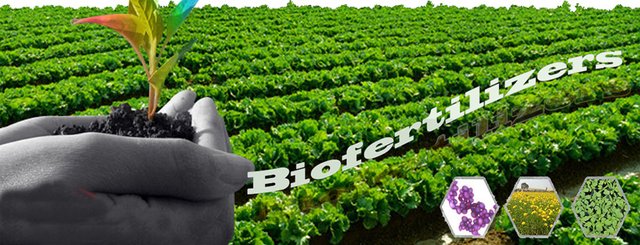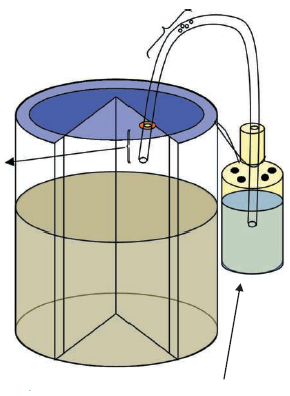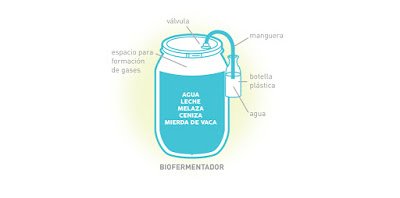Biofertilizers are natural liquid fertilizers, which are obtained by anaerobic fermentation, without air, that is, these liquids are obtained by the process of simplification of organic matter carried out by bacteria, in a medium without oxygen; organic matter is composed of fresh animal manure and enriched with microorganisms, milk, molasses and minerals, which remain for a certain time, until the microorganisms process these materials, since these organisms have the capacity to transform the nutrients of the soil to forms that are more assimilable to plants. These products can be used alone or in combination with chemical fertilizers in poor soils.

Source
¿Cómo se elaboran los biofertizantes?
Biofertilizers are obtained by exposing a certain amount of organic matter, such as cow dung, horse manure, before an anaerobic environment, so that the microorganisms are responsible for processing this mixture, passing through several stages, including the fermentation stage. This mixture which is carried out for several days in plastic tanks. Sometimes it is enriched with rock flour or mineral salts such as sulfates of magnesium, zinc, copper, these are dissolved in water and enriched with milk, molasses and ash; In many cases, products are used to accelerate fermentation, such as yeasts.
Materials for the preparation of biofertilizers:
In this opportunity, we are going to work with the 200-liter tank, which is the usual size of cylindrical tanks.
- A 200 liter tank with lid
- 130 liters of untreated water, (avoid contaminated water)
- 3 liters of milk or Serum:
- 5 liters of molasses or cane juice:
- 50 kg or 1/3 of the livestock manure tank
- 6 kg of ash
- 6 kg of dried neem leaves
- 3/4 inch plastic hose
- A plastic bottle of 2 to 4 liters
- Plastic black color, to cover the tank, in case of not having a lid.
Process for the preparation of biofertilizer - Prepare a plastic tank with a capacity of 200 liters, this is fitted with a sleeve on the lid, so that it seals well, because the tank must be hermetically sealed so that the anaerobic fermentation process can be carried out.

Source
- Place the tank under shade.
- Add 100 liters of water to the tank, and reserve the remaining 30 liters for the end.
- Place the rest of the materials, and with a wooden pallet move well until a slightly homogenous mixture is obtained; then add the remaining water.
- The next step is to place the 3/4 inch sleeve on the lid; If you do not have a cover, put the plastic cloth and put the hose that will serve as a vent.
- Once the tank is closed, we introduce the tip of the hose into the plastic bottle with water, as we said, this hose must be connected to the tank lid.

Source
The hose that has been connected to the tank lid or tied to the plastic fabric, is to evacuate the methane gases that are generated inside the tank. The tank should be moved with the paddle every 10 days. The process will be ready between 45 and 50 days.
How to know if the mixture is ready?
It is easy to detect when the process is over; when the mixture ceases to expel unpleasant odors and you only feel smells similar to that of the humid earth, this will indicate that the process has finished and you can already dispose of the product. But before using it is necessary to strain the liquid in a fine sieve or cloth, to avoid that the nozzles of the sprinklers become clogged. Then pack and store in cool and low light places.
Nutritional contributions of biofertilizers
Biofertilizers provide many vitamins, enzymes, amino acids, organic acids, antibiotics and a great microbial richness that contribute to dynamically balance the soil and the plant. When absorbed by leaves and roots, biofertilizers strengthen and stimulate the protection of crops. against the attack of pests, insects and diseases.
How to use this biofertilizer?
When we use fertilizers that we have bought in the agricultural stores, these products bring recommendations for their use, the recommended doses are based on the concentrations of the different components that have been previously analyzed. In the case of biofertilizers prepared by hand, the recommended doses are based on the experiences of farmers, but there is no need to be afraid of their application, since these natural products are very rich in nutrients but at moderate concentrations. easy to regulate.

Source
Recommended dosage of biofertilizers for plants.
Based on the amount of materials with which we have worked, the recommended dose, once you have prepared this biofertilizer, is one liter for each 20 liter sprinkler and complete with water; this is for foliar applications in plants. In soil applications, two liters are used for each 20 liter sprinkler and completed with water. These products are compatible with most fungicides, either of natural or chemical origin.
The biofertilizers are ideal to improve the substrates that we are going to use for the almacigo; also in the preparation of the land when direct seedbeds are made, since these help to improve the uptake of other nutrients such as phosphorus, copper and iron.
Advantages of using biofertilizers
- They allow to take advantage of organic waste.
- Increase soil microbial activity.
- They recover the organic matter of the soil, favoring the retention of nutrients and allow the fixation of carbon in the soil, as well as improve the capacity to absorb water.
- They usually need less energy to make it. Source
- Help improve the texture of the soil.
- They help to improve the productivity of crops, in addition, they can be used in most soils.
- They can be used to prepare or prepare land that has been widely used.
It is but that this information is very useful for those who like the crops, the biofertilizers can be used in the ornamental plants of the gardens and in pots. Greetings and until a next agricultural issue.
References: Source Source Source
This is truly useful to us @farms. Indeed we @farms find this post informative and educative, thanks for sharing
Resteem
(to be a part of this community; ensure to always use #farms and #steemchurch for agricultural related post)
Downvoting a post can decrease pending rewards and make it less visible. Common reasons:
Submit
Downvoting a post can decrease pending rewards and make it less visible. Common reasons:
Submit
Indeed the application of biofertilizers of crops will increase farm yield since its naturally prepared. 🖒
@oscarcede l would like to know if these are the only droppings you can use or there are more of these.?
Downvoting a post can decrease pending rewards and make it less visible. Common reasons:
Submit